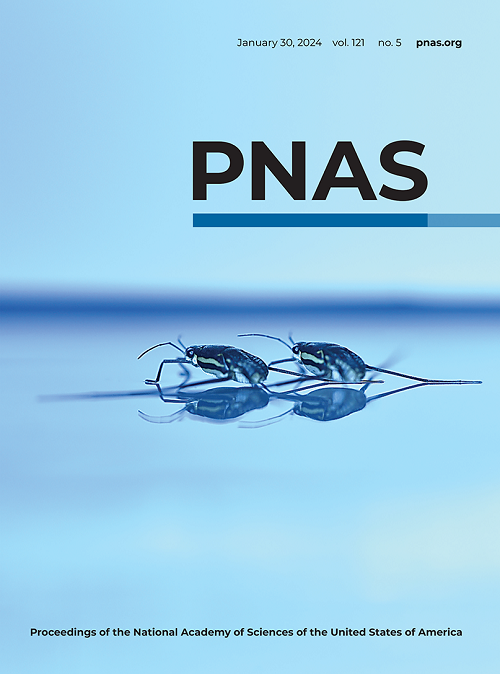Unraveling the origin of Kondo-like behavior in the 3d-electron heavy-fermion compound YFe2Ge2.
IF 9.4
1区 综合性期刊
Q1 MULTIDISCIPLINARY SCIENCES
Proceedings of the National Academy of Sciences of the United States of America
Pub Date : 2024-09-19
DOI:10.1073/pnas.2401430121
引用次数: 0
Abstract
The heavy fermion (HF) state of [Formula: see text]-electron systems is of great current interest since it exhibits various exotic phases and phenomena that are reminiscent of the Kondo effect in [Formula: see text]-electron HF systems. Here, we present a combined infrared spectroscopy and first-principles band structure calculation study of the [Formula: see text]-electron HF compound YFe[Formula: see text]Ge[Formula: see text]. The infrared response exhibits several charge-dynamical hallmarks of HF and a corresponding scaling behavior that resemble those of the [Formula: see text]-electron HF systems. In particular, the low-temperature spectra reveal a dramatic narrowing of the Drude response along with the appearance of a hybridization gap ([Formula: see text] 50 meV) and a strongly enhanced quasiparticle effective mass. Moreover, the temperature dependence of the infrared response indicates a crossover around [Formula: see text] 100 K from a coherent state at low temperature to a quasi-incoherent one at high temperature. Despite of these striking similarities, our band structure calculations suggest that the mechanism underlying the HF behavior in YFe[Formula: see text]Ge[Formula: see text] is distinct from the Kondo scenario of the [Formula: see text]-electron HF compounds and even from that of the [Formula: see text]-electron iron-arsenide superconductor KFe[Formula: see text]As[Formula: see text]. For the latter, the HF state is driven by orbital-selective correlations due to a strong Hund's coupling. Instead, for YFe[Formula: see text]Ge[Formula: see text] the HF behavior originates from the band flatness near the Fermi level induced by the combined effects of kinetic frustration from a destructive interference between the direct Fe-Fe and indirect Fe-Ge-Fe hoppings, band hybridization involving Fe [Formula: see text] and Y [Formula: see text] electrons, and electron correlations. This highlights that rather different mechanisms can be at the heart of the HF state in [Formula: see text]-electron systems.揭示 3d 电子重铁素体化合物 YFe2Ge2 中近藤样行为的起源。
由于[式:见正文]-电子系统的重费米子(HF)态表现出各种奇异的相位和现象,让人联想到[式:见正文]-电子 HF 系统中的近藤效应,因此它在当前引起了极大的兴趣。在此,我们对[式:见正文]-电子高频化合物 YFe[式:见正文]Ge[式:见正文]进行了红外光谱和第一原理能带结构计算的综合研究。红外响应显示出高频的几个电荷动力学特征,以及与[式:见正文]-电子高频系统相似的相应缩放行为。特别是,低温光谱显示德鲁德响应急剧缩小,同时出现了杂化间隙([式:见正文] 50 meV)和强烈增强的准粒子有效质量。此外,红外响应的温度依赖性表明,在 [公式:见正文] 100 K 左右,低温下的相干态与高温下的准不相干态发生了交叉。尽管存在这些惊人的相似之处,但我们的能带结构计算表明,YFe[式:见正文]Ge[式:见正文]中高频行为的基本机制不同于[式:见正文]电子高频化合物的 Kondo 方案,甚至也不同于[式:见正文]电子铁砷化物超导体 KFe[式:见正文]As[式:见正文]。对于后者来说,高频态是由轨道选择性相关性驱动的,而轨道选择性相关性是由强亨德耦合引起的。相反,对于 YFe[式:见正文]Ge[式:见正文]来说,高频行为源于费米级附近的能带平坦性,它是由直接铁-铁和间接铁-铁-铁跳变之间的破坏性干扰所产生的动能挫折、涉及铁[式:见正文]和 Y[式:见正文]电子的能带杂化以及电子相关的综合效应所引起的。这突出表明,在[式:见正文]电子系统中,高频状态的核心机制可能截然不同。
本文章由计算机程序翻译,如有差异,请以英文原文为准。
求助全文
约1分钟内获得全文
求助全文
来源期刊
CiteScore
19.00
自引率
0.90%
发文量
3575
审稿时长
2.5 months
期刊介绍:
The Proceedings of the National Academy of Sciences (PNAS), a peer-reviewed journal of the National Academy of Sciences (NAS), serves as an authoritative source for high-impact, original research across the biological, physical, and social sciences. With a global scope, the journal welcomes submissions from researchers worldwide, making it an inclusive platform for advancing scientific knowledge.

 求助内容:
求助内容: 应助结果提醒方式:
应助结果提醒方式:


